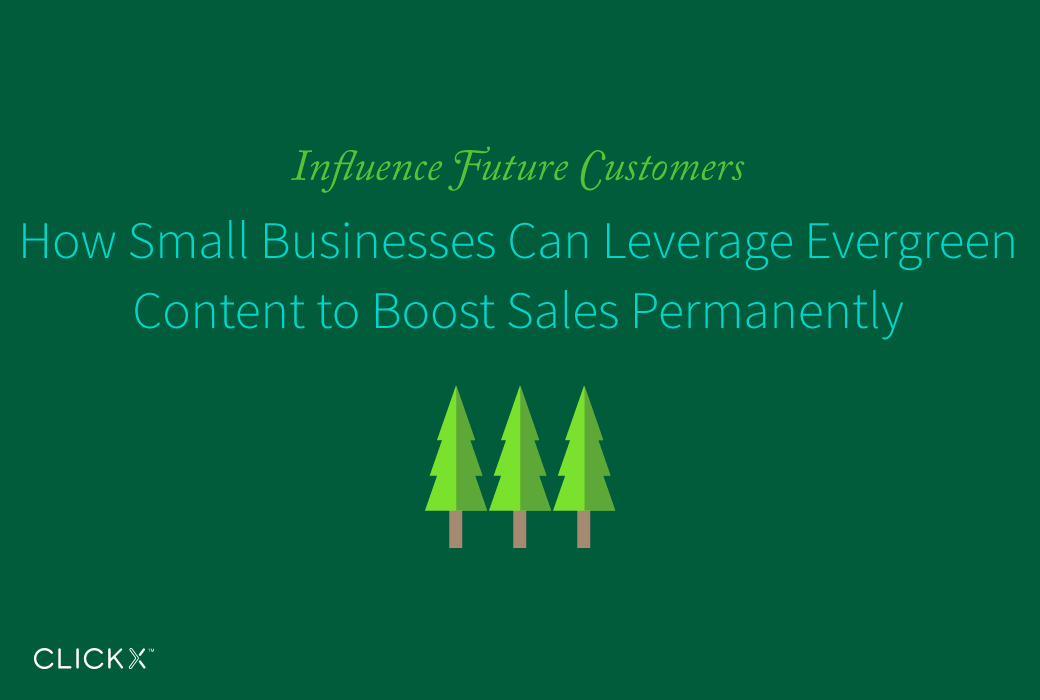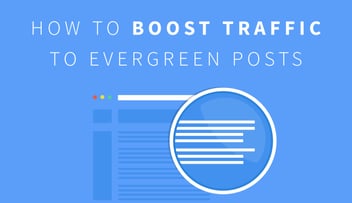How Small Businesses Can Leverage Evergreen Content to Boost Sales Permanently
When writing content for your business, it’s easy to forget that what you’re writing will be available online for the life of your website. Every word you write may influence the purchasing decisions of customers far into the future.
No matter your topic, it’s important to write through the lens of evergreen content so that it will remain relevant no matter when it is found.
In this post, you’ll learn both the value of evergreen content and how to start writing it for your business blog.

What Evergreen Content Is and Why It’s So Valuable
As you may know, ‘evergreen’ refers to a plant that remains green throughout the year—regardless of the weather.

After years of keyword stuffing, spun articles, and other passé old school SEO techniques, Google (and other search engines) finally caught on. The algorithms change routinely, but they always aim to favor content that was, is, and will continue to be valuable for the reader.
This is the art of writing ‘evergreen’ content; in other words, content that remains relevant no matter when it is read. Content that stays green throughout the year—regardless of the weather.
[Tweet “Evergreen content is important for SEO because the content of your blog builds on itself.”]
It will keep your content relevant over time, continuing to serve you in search engine results, and building up a readership when that future reader discovers you have a backlog of informative articles that teach them what they need to know.
The Basics of Writing Evergreen Content
Writing evergreen is choosing to write from a perspective that will always be relevant, no matter the topic. The word ‘perspective’ here is the combination of these elements: The format, the topic, and the phrasing.
 Choosing a Format
Choosing a Format
There are many options to choose from, but the following formats lend themselves to evergreen content nicely:
- How-tos
- Lists and roundups
- Informative Posts
- Q&As
- Interviews
The format of your post alone is not what makes your content evergreen, and these are not the only formats that are considered evergreen. These are merely a starting point.
If you choose to write content that may eventually go out of date—such as a list of free services—make sure that you review it regularly so that the content is still correct when it is found later. Evergreen content is always up to date.
Choosing a Topic
The topic of your post plays a big role in how relevant your post will be in a year’s time.
For example, “How to Find and Hire the Right Painting Contractor” (a how-to post) and “The Difference Between Hiring a Painter and a Painting Company” (an informative post) are both examples of what people will want to know now and in the future.
It’s okay to post time-sensitive announcements sometimes. However, if your blog only consists of your new locations or other information that becomes old news quickly, you may consider adding in some blog posts that will survive beyond the current season.
Avoid anything that is time-sensitive. You know what won’t matter after the named year is over? “Top 5 New Car Technologies and Innovations in 2015” (a list post). You know what people will want to learn about for the foreseeable future? “The Common Causes of a Check Engine Light” (an informative post).
When it comes to writing evergreen content, choose a concise topic and approach it from a beginner’s point of view.
[Tweet “Evergreen content is educational and comprehensive.”]
Choosing the Phrasing
The point of evergreen writing is to stop you from adding the kind of information that dates your article. Unless you are writing a series, just get to the point.
For example, you might be tempted to append the current year to your blog post, to prove that your post is relevant right now. But what happens the next year? Or the year after that? No one cares about your post then. Instead, write about “Driving Apps to Improve Your Road Trip”… period. That’s it.
Your readers should be able to learn from your article, understand how it relates to them, and be offered clearly defined steps to take next…no matter when they read it. Evergreen content is valuable, highly actionable, and relevant to your target audience.
Evergreen Content Prompts
As a small business, the best content marketing educates your readers. Here are some easy prompts to help you come up with evergreen post ideas:
- What steps do customers go through before finding your business? Write how-to articles to address these steps. Examples: “Tips for Selecting the Right Computer Repair Company” and “Choosing the Perfect Paint Color”.
- Educate your customers. Write definitive articles about the acronyms, lingo, technology, or techniques involved in your business. Examples: “25 Basic Stock Market Trading Terms You Should Know” and “Cedar Shingles vs. Shakes – Wood Roofing Materials”.
- Curate lists of relevant resources that your customers may be searching for. Examples: “Top 50 Auto Blogs” and “The 10 Blogs Every Old House Lover Should Follow”.
- Write about what’s difficult in your industry, in a funny way. Highlight how to handle these difficulties. (People don’t do this a lot. Break the trend!)
Applying Evergreen to Time-Sensitive Pieces
In spite of our general advice to avoid time-sensitive material, you can still apply these techniques to content that would not normally be considered evergreen.

Take, for example, a blog post announcing the new location of your business.
Not evergreen: A typical news announcement. Evergreen: A post about the importance of community and the role a local business plays in that community, alongside the information about your new location.
Even when writing time-sensitive material, you can often give it evergreen treatment by focusing on the lessons learned (i.e. the takeaway) from that event, rather than on the event itself.
How to Leverage Evergreen Content for More Sales
Every post written on a company blog contributes to the voice, character, and trustworthiness of the brand.
As such, you can improve your sales by adding one more layer of consideration when writing a post: Which product or service does this post support? It doesn’t have to be a direct correlation, but it’s good to have in mind how your content ties back into your business.
Write to (ethically) educate your readers about the problems and solutions related to your business’s services or products. Don’t focus completely on your own solutions, but do become a source of reliable education for your readers.
By writing evergreen content, you are likely to attract more attention from people seeking what you have to offer. Forever.
Conclusion
Unfocused, ‘out-of-date’ writing can hurt your brand, decrease sales, and lose potential customer interest if it ever does get found. At best, it can keep you invisible.
Instead, write comprehensive evergreen content, apply similar principles to time-sensitive pieces, and become a trusted source of education for your readers and potential customers.
How can you apply this to your own company? What perspective can you write from that will produce evergreen content for your blog? Tell us how you plan to take advantage of evergreen content in the comments.

.webp?width=1201&height=801&name=woman-hand-desk-office%20(1).webp)


